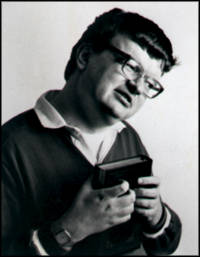Related Research Articles

Asperger syndrome (AS), also known as Asperger's syndrome, formerly described a neurodevelopmental disorder characterized by significant difficulties in social interaction and nonverbal communication combined with restricted and repetitive patterns of behavior and interests. The syndrome has been merged with other disorders into autism spectrum disorder (ASD) and is no longer considered a stand-alone diagnosis. It was considered to differ from other diagnoses that were merged into ASD by relatively unimpaired spoken language and intelligence.

Savant syndrome is a phenomenon where someone demonstrates exceptional aptitude in one domain, such as art or mathematics, despite significant social or intellectual impairment.
In psychology, theory of mind refers to the capacity to understand other people by ascribing mental states to them. A theory of mind includes the knowledge that others' beliefs, desires, intentions, emotions, and thoughts may be different from one's own. Possessing a functional theory of mind is crucial for success in everyday human social interactions. People utilise a theory of mind when analyzing, judging, and inferring others' behaviors. The discovery and development of theory of mind primarily came from studies done with animals and infants. Factors including drug and alcohol consumption, language development, cognitive delays, age, and culture can affect a person's capacity to display theory of mind. Having a theory of mind is similar to but not identical with having the capacity for empathy or sympathy.

Sir Simon Philip Baron-Cohen is a British clinical psychologist and professor of developmental psychopathology at the University of Cambridge. He is the director of the university's Autism Research Centre and a Fellow of Trinity College.

A block design test is a subtest on many IQ test batteries used as part of assessment of human intelligence. It is thought to tap spatial visualization ability and motor skill. The test-taker uses hand movements to rearrange blocks that have various color patterns on different sides to match a pattern. The items in a block design test can be scored both by accuracy in matching the pattern and by speed in completing each item.

Michelle Dawson is a Canadian autism researcher who was diagnosed with autism in 1993–1994. Since 2004, she has worked as an autism researcher affiliated with the Autism Specialized Clinic of Hôpital Rivière-des-Prairies in Montreal, Quebec, Canada.
The following outline is provided as an overview of and topical guide to autism:
Mind-blindness, mindblindness or mind blindness is a theory initially proposed in 1990 that claims that all autistic people have a lack or developmental delay of theory of mind (ToM), meaning they are unable to attribute mental states to others. According to the theory, a lack of ToM is considered equivalent to a lack of both cognitive and affective empathy. In the context of the theory, mind-blindness implies being unable to predict behavior and attribute mental states including beliefs, desires, emotions, or intentions of other people. The mind-blindness theory asserts that children who delay in this development will often develop autism.

The heritability of autism is the proportion of differences in expression of autism that can be explained by genetic variation; if the heritability of a condition is high, then the condition is considered to be primarily genetic. Autism has a strong genetic basis. Although the genetics of autism are complex, autism spectrum disorder (ASD) is explained more by multigene effects than by rare mutations with large effects.

Uta Frith is a German-British developmental psychologist and Emeritus Professor in Cognitive Development at the Institute of Cognitive Neuroscience at University College London (UCL). She pioneered much of the current research into autism and dyslexia. Her book Autism: Explaining the Enigma introduced the cognitive neuroscience of autism. She is credited with creating the Sally–Anne test along with fellow scientists Alan Leslie and Simon Baron-Cohen. Among students she has mentored are Tony Attwood, Maggie Snowling, Simon Baron-Cohen and Francesca Happé.

Autism: Explaining the Enigma is a 1989 nonfiction book by psychologist Uta Frith.

Classic autism, also known as childhood autism, autistic disorder, (early) infantile autism, infantile psychosis, Kanner's autism,Kanner's syndrome, or (formerly) just autism, is a neurodevelopmental condition first described by Leo Kanner in 1943. It is characterized by atypical and impaired development in social interaction and communication as well as restricted, repetitive behaviors, activities, and interests. These symptoms first appear in early childhood and persist throughout life.
Images and other stimuli contain both local features and global features. Precedence refers to the level of processing to which attention is first directed. Global precedence occurs when an individual more readily identifies the global feature when presented with a stimulus containing both global and local features. The global aspect of an object embodies the larger, overall image as a whole, whereas the local aspect consists of the individual features that make up this larger whole. Global processing is the act of processing a visual stimulus holistically. Although global precedence is generally more prevalent than local precedence, local precedence also occurs under certain circumstances and for certain individuals. Global precedence is closely related to the Gestalt principles of grouping in that the global whole is a grouping of proximal and similar objects. Within global precedence, there is also the global interference effect, which occurs when an individual is directed to identify the local characteristic, and the global characteristic subsequently interferes by slowing the reaction time.
This relationship between autism and memory, specifically memory functions in relation to Autism Spectrum Disorder (ASD), has been an ongoing topic of research. ASD is a neurodevelopmental disorder characterised by social communication and interaction impairments, along with restricted and repetitive patterns of behavior. In this article, the word autism is used to refer to the whole range of conditions on the autism spectrum, which are not uncommon.
Laurent Mottron, born June 13, 1952, in France, is a psychiatrist, researcher, and a professor at Montreal University. He is a specialist in cognitive neuroscience research in autism at the University of Montreal.

Francesca Gabrielle Elizabeth Happé is Professor of Cognitive Neuroscience and Director of the MRC Social, Genetic and Developmental Psychiatry Centre at the Institute of Psychiatry, Psychology and Neuroscience, King's College London. Her research concerns autism spectrum conditions, specifically the understanding social cognitive processes in these conditions.
The Emanuel Miller Memorial Lectures commemorate the British child psychiatrist Emanuel Miller (1892–1970). The Association for Child and Adolescent Mental Health began them in 1972.
The mechanisms of autism are the molecular and cellular processes believed to cause or contribute to the symptoms of autism. Multiple processes are hypothesized to explain different autism spectrum features. These hypotheses include defects in synapse structure and function, reduced synaptic plasticity, disrupted neural circuit function, gut–brain axis dyshomeostasis, neuroinflammation, and altered brain structure or connectivity.
Social (pragmatic) communication disorder (SPCD), also known as pragmatic language impairment (PLI), is a neurodevelopmental disorder characterized by significant difficulties in the social use of verbal and nonverbal communication. Individuals with SPCD struggle to effectively engage in social interactions, interpret social cues, and use language appropriately in social contexts. This disorder can have a profound impact on an individual's ability to establish and maintain relationships, navigate social situations, and participate in academic and professional settings. Although SPCD shares similarities with other communication disorders, such as autism spectrum disorder (ASD), it is recognized as a distinct diagnostic category with its own set of diagnostic criteria and features.

The theory of the double empathy problem is a psychological and sociological theory first coined in 2012 by Damian Milton, an autistic autism researcher. This theory proposes that many of the difficulties autistic individuals face when socializing with non-autistic individuals are due, in part, to a lack of mutual understanding between the two groups, meaning that most autistic people struggle to understand and empathize with non-autistic people, whereas most non-autistic people also struggle to understand and empathize with autistic people. This lack of understanding may stem from bidirectional differences in communication style, social-cognitive characteristics, and experiences between autistic and non-autistic individuals, but not necessarily an inherent deficiency. Recent studies have shown that most autistic individuals are able to socialize, communicate effectively, empathize well, and display social reciprocity with most other autistic individuals. This theory and subsequent findings challenge the commonly held belief that the social skills of autistic individuals are inherently impaired, as well as the theory of "mind-blindness" proposed by prominent autism researcher Simon Baron-Cohen in the mid-1980s, which suggested that empathy and theory of mind are universally impaired in autistic individuals.
References
- ↑ Autism: Explaining the Enigma (1989).
- ↑ Frith, Uta (2008). "Weak central coherence (p. 90ff.)". Autism. A Very Short Introduction. Oxford University Press. ISBN 978-0-1992-0756-5.
- ↑ Happé, F.; Frith, U. (2006). "The Weak Coherence Account: Detail-focused Cognitive Style in Autism Spectrum Disorders". Journal of Autism and Developmental Disorders . Springer Science+Business Media. 36 (1): 5–25. doi:10.1007/s10803-005-0039-0. PMID 16450045. S2CID 14999943.
- ↑ Natasja van Lang (2003) "Autism spectrum disorders: a study of symptom domains and weak central coherence" p. 59, (reference for the paragraph starting with "In the last decade").
- ↑ Sally Ozonoff, David L. Strayer, William M. McMahon, Francis Filloux (1994) "Executive Function Abilities in Autism and Tourette Syndrome: An Information Processing Approach" Journal of Child Psychology and Psychiatry 35 (6), 1015–1032. doi : 10.1111/j.1469-7610.1994.tb01807.x
- ↑ Laurent Mottron, Jacob A. Burack, Johannes E. A. Stauder, Philippe Robaey (1999) "Perceptual Processing among High-functioning Persons with Autism" Journal of Child Psychology and Psychiatry 40 (2), 203–211. doi : 10.1111/1469-7610.00433
- ↑ Laurent Mottron, Jacob A. Burack, Grace Iarocci, Sylvie Belleville, James T. Enns (2003) "Locally oriented perception with intact global processing among adolescents with high-functioning autism: evidence from multiple paradigms" Journal of Child Psychology and Psychiatry 44 (6), 904–913. doi : 10.1111/1469-7610.00174
- ↑ Beatriz López, Susan R. Leekam (2003) "Do children with autism fail to process information in context?" Journal of Child Psychology and Psychiatry 44 (2), 285–300. doi : 10.1111/1469-7610.00121
- ↑ Natasja van Lang (2003) "Autism spectrum disorders: a study of symptom domains and weak central coherence" p. 59.